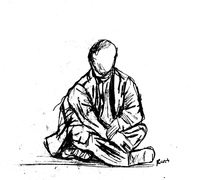Gesture Drawing

A gesture drawing is quickly and loosely drawn to capture movement. The lines of the drawing should appear to have been made quickly to catch the action of the subject/figure.
Creating gesture drawings will help improve your drawing skills in the following ways:
· It forces you to see the model and the model’s movement as a single image not one detail at a time.
· It helps you forget your childhood habit of outlining all the shapes in the drawing. Outlining can be slow, stiff and frustrating. Ignore the outlines, and make the shapes by “scribbling” them.
· It helps you begin the drawing process as you immediately put expressive marks on the paper.
Creating gesture drawings will help improve your drawing skills in the following ways:
· It forces you to see the model and the model’s movement as a single image not one detail at a time.
· It helps you forget your childhood habit of outlining all the shapes in the drawing. Outlining can be slow, stiff and frustrating. Ignore the outlines, and make the shapes by “scribbling” them.
· It helps you begin the drawing process as you immediately put expressive marks on the paper.